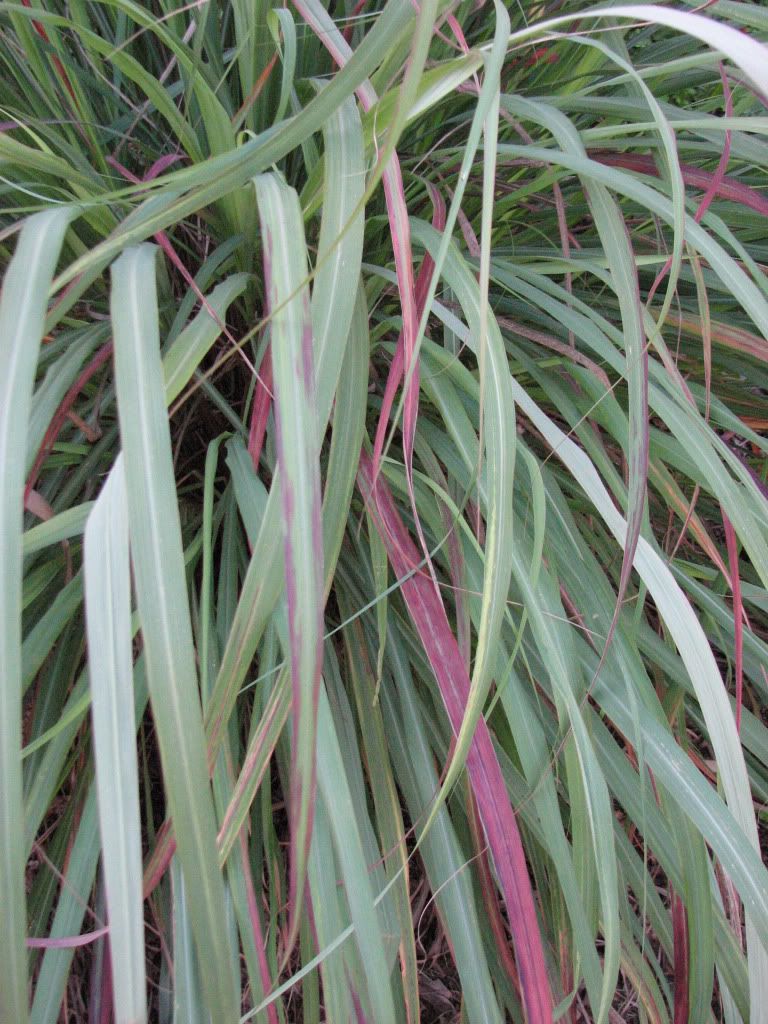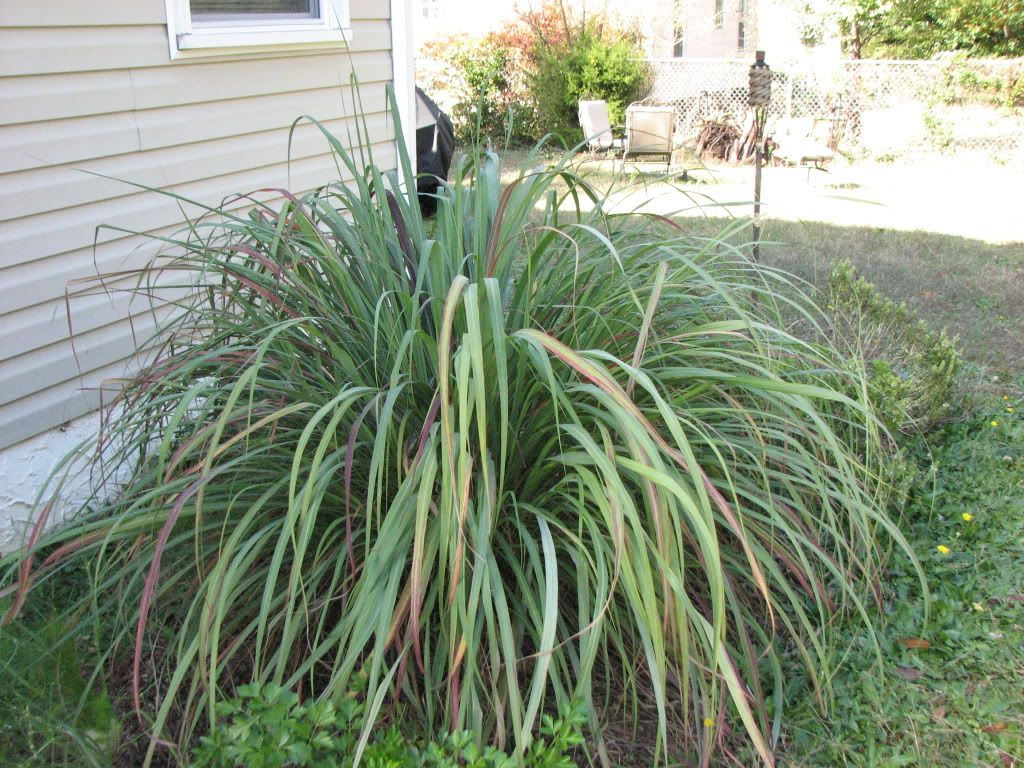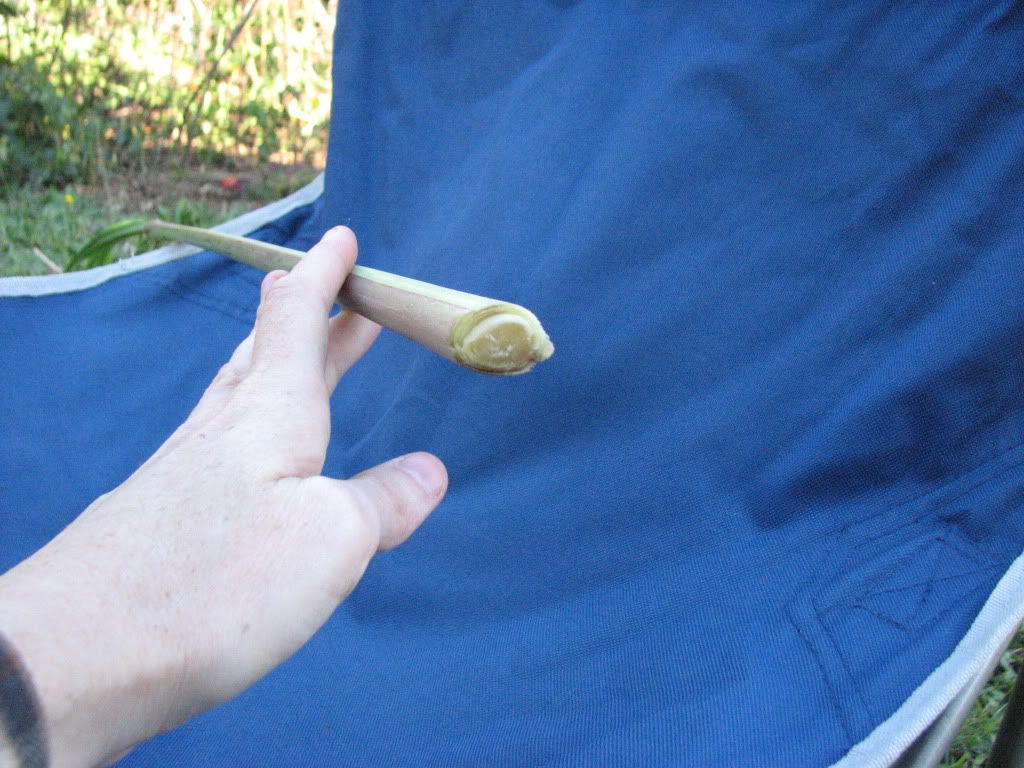How to Grow and Use Lemon Grass as a Kitchen Ornamental (with Recipes)
Lemon grass (Cymbopogon citratus) deserves a more prominent place in our herb gardens, kitchens, and even the ornamental landscape. I think it is one of the prettiest plants in the garden!

Photo Caption: Lemon grass doesn't like the cold but it starts to get beautiful magenta highlights in the fall before the real freezes hit.
Lemon grass looks just as nice in the flower border as it does in the kitchen garden. You can put a grouping of it in your rose beds or mix it with echinaceas, tall salvias, and bold perennial hibiscus. Even as a single specimen its fountain of quaking leaves will draw plenty of attention.
Grow it as an annual or perennial, depending on where you live. I find that it is hardy some years in my zone 7b garden, but not always. It also benefits from a good microclimate and heavy mulch to protect it in the wintertime. Sometimes I just stick a large clay pot on top of it and let the dying grass from the previous season insulate the crown and roots. It also does well in pots if it is protected from the cold months.
One year in October I dug up the entire 4′ tall, 2′ wide plant, potted it, and brought it inside for the winter. To my surprise it did great in the sunny kitchen window and transplanted back into the herb bed with ease the next spring. I had fresh lemon grass in February and no wait for a harvest-size plant the following season. (The only downside was just after I brought the plant indoors — I found a black widow spider parachuting down the side of the pot). Bleagh!

Photo Caption: It's easy to pick up a handful of little herb transplants in the spring and not realize that the parsley can't survive only a foot away from that tiny slip of lemon grass. Give it a few months and you'll discover it requires at least a 3' foorprint so that it doesn't compete with other plants. It's also a good idea to mark young lemon grass with a distinctive tag -- otherwise you may forget what it is and pull that "weedy" grass seedling.
Many home cooks find lemon grass intimidating even though it is easy to use. This website shows an excellent photo tutorial on how to prepare lemon grass for cooking. An important step is to crush the lemon grass with the flat blade of a knife to release the flavor before mincing or shredding it.
The standard technique for harvesting lemon grass is to grasp a single stalk and yank it up (roots and all) from the base of the plant. I don’t do this. Since I’m going to be cutting off the bottom 1″ near the root anyway, I just harvest my lemon grass by slicing it as close to the ground as possible with a knife or scissors. This keeps me from pulling up more than I need and making my plant look mangy.

Photo Caption: Instead of ripping out parts of my plant (with the risk of tearing off too much), I choose the fattest grass stalk and cut it as close to the base as possible.
If I needed other vegetables for the night’s meal, the lemon grass is often the last thing I harvest. I make sure not to put the cut end on the ground so it doesn’t collect dirt.

Photo Caption: After cutting it from the plant I usually chop the green, tough upper leaves off (leaving about a 6" - 8" section of tight, blanched stalk) and put the excess leaves in the compost before going inside.
You’ll need to choose what type of lemon grass to buy for your garden. The best lemon grass (with consistently thick stalks) is supposed to be a cloned variety from West India. The grown-from-seed transplants at garden nurseries are more variable in their culinary qualities. Either kind has the bushy form that looks great as an ornamental.
If you need a lot of plants, the most inexpensive source is to start from seeds. The cloned varieties are more expensive and are usually sold bareroot. Potential sources include local garden centers, Pinetree Seeds, Park Seed, Johnny’s Selected Seeds, and Richter’s Herbs. Seeds can take a while to germinate (up to 40 days). You can also look at the grocery for whole lemon grass stalks that still have some roots on them. If they aren’t too dried out they may sprout in the garden. Try soaking them for at least an hour (but no more than 24 hours) before planting them out (the same way as bareroot plants) after all danger of frost is past.
If you aren’t growing lemon grass you can still enjoy these recipes after a trip to the store. Some groceries don’t carry lemon grass so you may need to check for an Asian grocery in your area.
Recipe for Thai Garden Soup With Lemon Grass (serves 4, or 6 as an appetizer)
Vegetables:
- 1/2 lbs small mild-tasting mushrooms (wild foraged or from specialty section in grocery) or regular mushrooms (button, etc.) cut into 1/2″ chunks
- 1 medium zucchini or summer squash (grated or sliced into 1/2″ slivers)
- 1 medium eggplant, preferably a long Thai, Japanese, or Chinese variety (sliced into 1/2″ slivers). If it is a grocery store eggplant (instead of garden-grown) it may be bitter and benefit from being peeled first. Young garden-grown eggplant are rarely bitter.
- 1/3 cup sliced cherry tomatoes (additional tomatoes in broth)
Broth:
- 1 tablespoon peanut oil
- 1/3 cup minced shallots or red onion
- 4 garlic cloves, minced
- 1 – 4 small seeded & minced chilies (you choose the heat level: Thai , Jalapeño, etc.)
- 4 cups water
- 1/4 cup + 1 tbsp lime juice
- 2 tbsp soy sauce
- 2 cups tomatoes, peeled, seeded, and coarsely chopped
- 3 kaffir lime leaves or two 2″ x 1/2″ strips of lime zest
- 4″ length of lemon grass heart, finely sliced
- Three 1/8″ slices of fresh galangal or ginger root
- One 14oz can coconut milk (optional — leave out for lower calories)
- 3 tbsp chopped fresh cilantro
- 2 tbsp chopped fresh basil (Thai basil if possible)
- For broth, heat peanut oil in a large metal soup pot over medium heat and stir in shallots, garlic, and chilies. Stir every couple of minutes until fragrant and soft
- Add water, lime juice, soy sauce, and broth tomatoes (reserve cherry tomatoes until later) and bring to slow simmer. Add lime leaves (or zest), lemon grass, and galangal (or ginger)
- Add vegetables (except cherry tomatoes) to soup and simmer gently until they feel slightly soft, about 10 minutes
- About 1 minute before serving, stir in coconut milk, cilantro, basil, and cherry tomatoes (Optional: at this time remove lime leaves, zest, lemon grass, and galangal slices. Let your guests know to eat around them if you leave them in the soup.)
- Optional: For more sour flavor, add more lime juice just before serving. Check if salty enough before serving.
Here’s some more places with lemon grass recipes:
- Lemon Grass @ Allrecipes.com
- Lemongrass @ Allrecipes.com (spelling it as a compound word gets different search results)
- Lemon Grass @ Epicurean.com
- Iced Green Tea with Lemongrass @ The Global Gourmet
- Hot Lemon Grass Tea @ eHow
- Vietnamese Lemon Grass Green Beans & Tofu @ Herbivoracious
- Lemon Grass Paste @ Martha Stewart.com (can be frozen and kept for later use)
7 thoughts on “How to Grow and Use Lemon Grass as a Kitchen Ornamental (with Recipes)”
Comments are closed.

Daricia
Twitter: aCLTgarden
- November 27, 2010 7:16 pm
i agree with you about lemon grass. it is an impressive plant in the garden – useful and beautiful, too. we should definitely use it more often. i have to remind myself not to get cut on the leaves because the edges are razor sharp, which is the only small drawback i can think of. i have a habit of touching every plant it see! i have never had it survive the winter outside in my charlotte garden. i am glad to know it did so well inside for you. lots of good info here…thanks!
.-= Daricia´s last blog ..The Lumber River at Fair Bluff =-.
Sustainahillbilly
Twitter: appalachianfeet
- November 30, 2010 9:02 am
That’s true — I tend to be sorry when I harvest from the plant without wearing gloves. Charlotte seems like it would have a similar climate to where I’m at — maybe you’ll get lucky one year!
.-= Sustainahillbilly´s last blog ..How to Find Great Plants- Issue 1 =-.
Diana - December 1, 2010 1:42 am
I used to dread it when mama asked me to take some lemongrass from her garden for her cooking. But now I am a skilled lemongrass harvester.
.-= Diana´s last blog ..UP UP UP!!! =-.
Sustainahillbilly
Twitter: appalachianfeet
- December 1, 2010 8:30 am
Good for you!
.-= Sustainahillbilly´s last blog ..How to Submit Entries for How to Find Great Plants- Issue 2 =-.
Janet/Plantaliscious - December 1, 2010 7:24 am
I’m going to have to give growing lemongrass a go next year, probably in a pot. I love cooking with it so much, but it is expensive to buy locally and often very woody.
.-= Janet/Plantaliscious´s last blog ..Wordless Wednesday- Frost-kissed windows =-.
Sustainahillbilly
Twitter: appalachianfeet
- December 1, 2010 8:32 am
I didn’t think of store-bought lemongrass being woody but that makes sense. I wonder if it is because it has dehydrated and stiffened, or if there is an ideal “ripe” stage, like with leeks. So far I haven’t harvested any overly-woody segments from the plants I grew, but then most of my plants end up being annuals so they probably wouldn’t have time to get tough.
.-= Sustainahillbilly´s last blog ..How to Submit Entries for How to Find Great Plants- Issue 2 =-.
fer
Twitter: mygardeninjapan
- December 17, 2010 6:45 am
Very good idea about the lemon grass. I would like to try it someday if I have the space
.-= fer´s last blog ..Coldframe V20 =-.